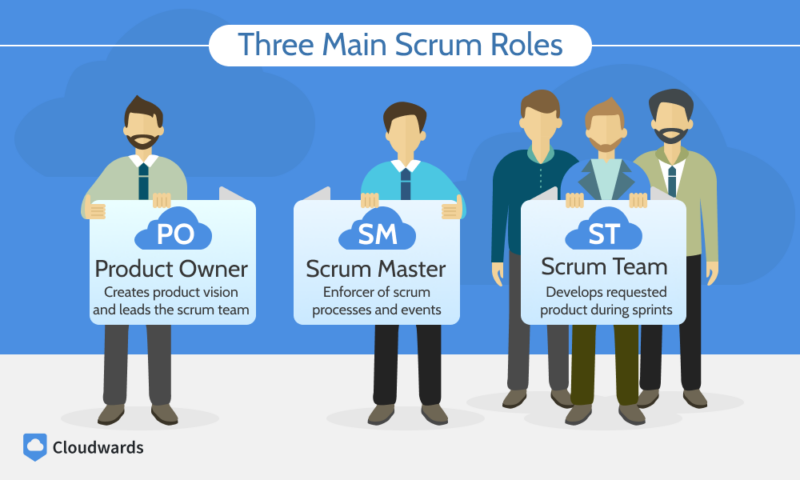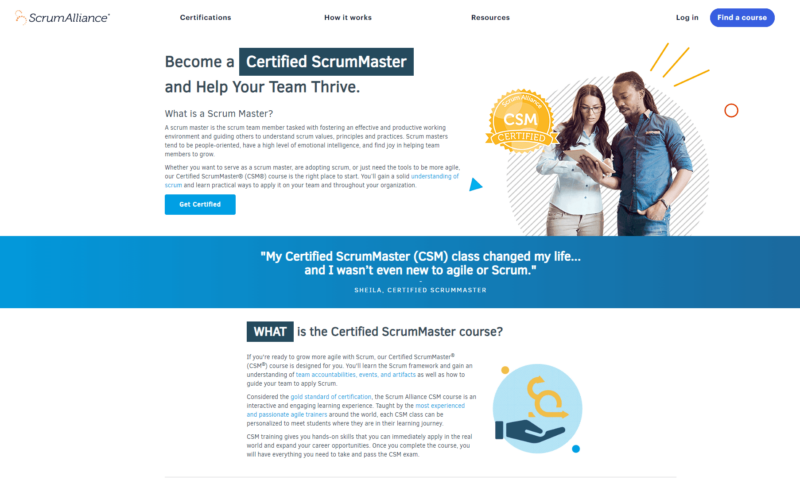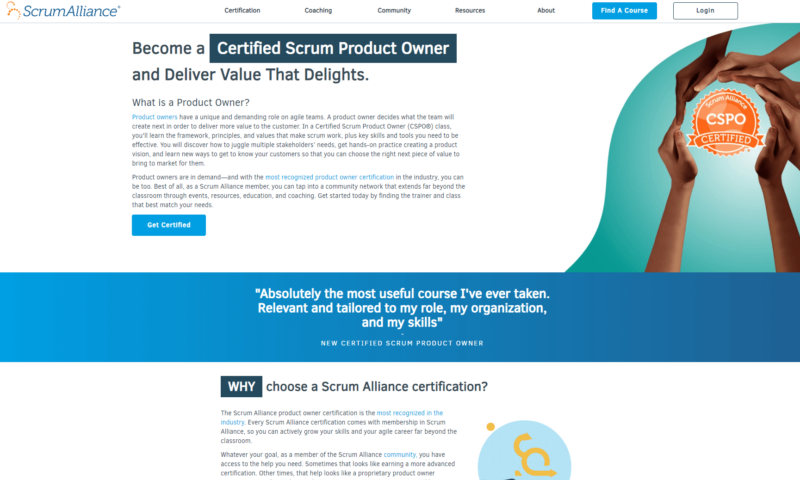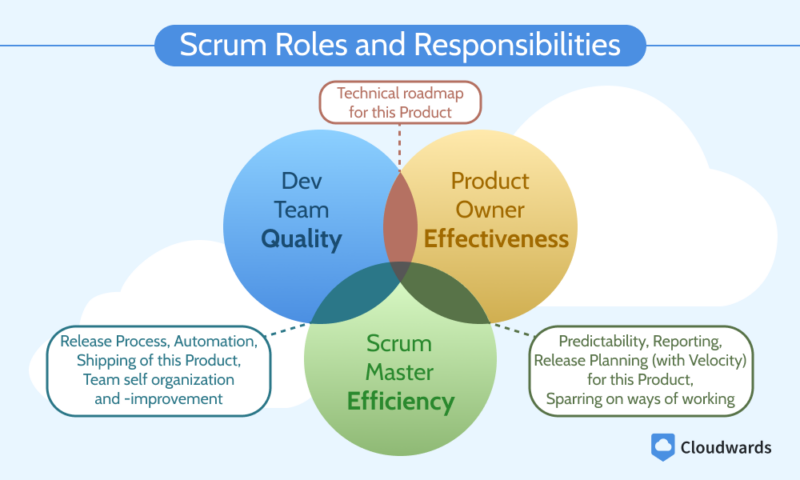Scrum Roles and Responsibilities: Explained With Venn Diagram 2025
If you’re new to the world of Scrum and are unfamiliar with scrum roles and responsibilities, our handy guide will teach you all you need to know. Learn about each position so you can better understand what a scrum team is and how these agile teams work.
Thanks to the rapid adoption of Agile frameworks, Scrum is now a familiar project management method for organizations in software development, manufacturing, education, marketing and more. However, to form successful scrum teams, you need to know the ins and outs of the Scrum framework, as well as scrum roles and responsibilities.
In this guide, you’ll learn what the different scrum roles are, how a scrum team works and what scrum events are. You’ll also learn about the scrum master, product owner and development team’s responsibilities. We know you’re eager to learn, so let’s begin.
-
07/17/2024
Updated the article to add custom graphics.
What Are the Different Roles in Scrum?
There are three key roles in Scrum: scrum master, product owner and software developer. Scrum teams are cross-functional, self-managing teams that contain five to nine people. Stakeholders and clients interact and collaborate with all team members, but they aren’t included in the official Scrum roles. We’ll examine each role in the coming sections.

Scrum Master
The scrum master acts as a change agent, helping teams adapt to new projects and demands while providing guidance throughout the project’s lifecycle. Scrum masters also facilitate meetings and collaboration, ensuring that the development team, also known as a feature team, doesn’t get overwhelmed and the team follows Agile principles and guidelines.
It’s important to note that scrum masters are not project managers. A project manager manages an entire project from start to finish. In Scrum, the scrum master and product owner work together to guide the development team. Below are the key scrum master responsibilities:
- Leading meetings: The scrum master leads scrum events like sprint planning sessions, sprint reviews, daily scrums and sprint retrospectives.
- Coaching: Scrum masters are responsible for coaching the development team to operate and collaborate autonomously during the development stage. They also ensure that scrum anti-patterns don’t become a problem.
- Promoting Agile: A scrum master ensures that every team member is on board with scrum principles, as well as agile principles and guidelines, making sure that the entire organization understands their importance.
- Assigning project tasks: While the product owner (PO) owns the product backlog, the scrum master confirms that the PO and the development team agree on the features (tasks) that are assigned to each developer.

widely recognized scrum master certifications.
Many certifications are available for those wishing to become an agile scrum master. The two most popular choices are the Professional Scrum Master and Certified Scrum Master certifications offered by the Scrum Alliance and Scrum.org. The scrum master role is quite lucrative, with the average U.S. salary being approximately $120,000 annually.1
Product Owner
The product owner (PO) is responsible for making all choices regarding product development. This includes planning sprints, setting sprint goals and refining the backlog. POs also define the definition of ready (when a task is ready to be worked on) and the definition of done (the criteria that a task must meet to be considered complete).
Product owners are also tasked with developing the product vision (goal) and communicating directly with key stakeholders, clients and the product development team. Here are the key product owner responsibilities:
- Managing stakeholders and clients: Product owners communicate directly with stakeholders and clients to understand their needs, develop the product vision and gather feedback.
- Managing the backlog: The PO owns the product backlog and all of its features (tasks). During backlog refinement sessions, the PO adds, prioritizes and assigns tasks, ensuring that each feature is fully defined before the work begins.
- Conducting sprint reviews: During sprint reviews, the product owner and the development team demo the latest iteration of working software to stakeholders and clients. They also listen to concerns, gather feedback and note new feature requests.
Offered by the Scrum Alliance and Scrum.org, the Certified Scrum Product Owner and Professional Scrum Product Owner credentials are the two most recognized certifications for this position. Individuals with a product owner certification can earn roughly $112,000 annually in the U.S.2

Development Team
In the Scrum methodology, the development team makes up about 80% of the team as a whole. Development team members define features and also develop the product or the next software iteration for stakeholders and clients. Development teams are cross-functional, meaning each scrum developer is highly skilled and can work in multiple areas of development.
They are also self-managing and collaborative. They work together to solve problems, and they reach goals without the assistance of the scrum master or PO. During a sprint review, the development team is also responsible for showcasing the latest iteration of working software to stakeholders and clients, alongside the PO. The key dev team responsibilities are as follows:
- Developing the product: The development team is tasked with creating frequent working iterations of software (or any other product type), along with identifying and fixing bugs during time-boxed work periods called sprints. Each sprint lasts between one and four weeks.
- Participating in ceremonies: Development team members must update the scrum master during daily scrums, assist the PO during sprint planning meetings and be active in sprint reviews. The development team must also attend sprint retrospective meetings.
- Defining features: Alongside the PO, the dev team helps define feature stories (what the feature must do), outlining how they should work and what they will look like. These are developed using the “definition of ready and done” documents. The dev team also uses agile estimation techniques to define how easy or hard a feature will be to develop.
- Collaborating: To successfully complete a scrum project, the development team has to collaborate. Developers must be willing to help others, listen and provide feedback to the PO and scrum master, and work directly with clients and stakeholders.

If you’re interested in becoming a scrum developer, you might want to take a closer look at some certifications. The most well-respected certifications are the Certified Scrum Developer (CSD) and Professional Scrum Developer (PSD) credentials, offered by the Scrum Alliance and Scrum.org. In the U.S., scrum developers can expect to earn roughly $129,000 annually.3
Scrum Roles and Responsibilities Venn Diagram
As you can see from the lists above, scrum team members have some overlapping responsibilities. This should come as no surprise, as Scrum is a highly collaborative framework. Scrum masters and POs are both tasked with reporting and determining the best way forward throughout the project.
The PO and the development team are each responsible for producing the product roadmap and defining product features, while the dev team and the scrum master’s tasks overlap when defining self-organization, self-management and continuous improvement goals. Our Venn diagram below helps to better depict these overlaps.

Scrum Team Meetings
The Scrum framework includes many ceremonies and events (meetings). Below, we’ll briefly cover how each team member participates in each ceremony.
Final Thoughts
You now know that scrum masters are the glue that holds scrum teams together; the product owner has stellar communication skills, plus the vision and knowledge to design a project plan; and the development team has the skills to bring the product to life. These scrum roles combine to deliver high-quality products quickly and increase customer satisfaction.
After reading our guide, has your interest in any scrum roles increased? What scrum software does your team use to plan and track projects? Have we missed anything in our guide that you’d like to share? Let us know in the comments. Thanks for reading.
FAQ: Scrum Team Roles
A scrum team consists of three roles: a scrum master, the development team and a product owner.
The scrum master is accountable for the whole project and the team’s well-being. The product owner creates the product vision, communicates with stakeholders and clients, and takes responsibility for the product that’s being built. The development team builds, tests and demos the software or product requested by the stakeholders or client.
The three agile roles in Scrum are the scrum master, product owner and software developer.
Sources:


